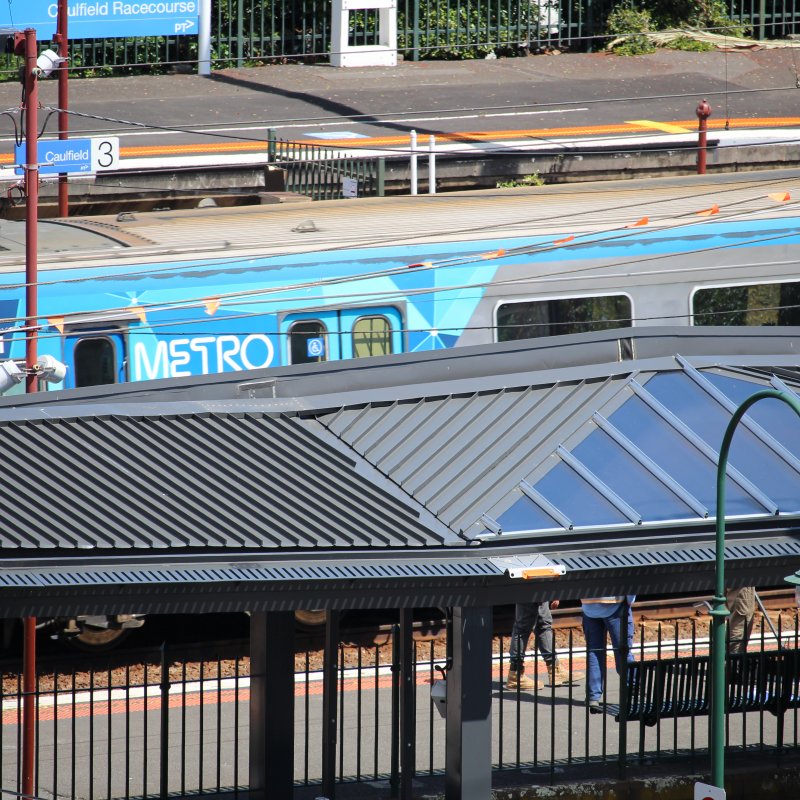When two new covered walkways were required at Melbourne's historic Caulfield Station, to protect commuters from the elements while also complementing the heritage qualities of the site, Melbourne-based Kyriacou Architects specified LYAGHT LONGLINE 305® roofing to deliver dramatic lines atop the sculptural, winglike structures they created.
Used in this project
- Products
- LYSAGHT LONGLINE 305®
- Materials
- COLORBOND® steel - Classic finish
- Colours
-

When two new covered walkways were required at Melbourne's historic Caulfield Station, to protect commuters from the elements while also complementing the heritage qualities of the site, Melbourne-based Kyriacou Architects specified LYAGHT LONGLINE 305® roofing to deliver dramatic lines atop the sculptural, winglike structures they created.
Situated eight kilometres from the Melbourne CBD near Caulfield Racecourse, home of some of Australia's most famous and historic horse races, Caulfield Railway Station is itself a place of historical, architectural and aesthetic value to the state of Victoria.
Registered with Heritage Victoria, the imposing Federation Free Style complex was constructed in 1913-14 and is an important example of the Victorian Way and Works Architect, J.W. Hardy, with details of note including cement render banding terminating in a radiating design around the archways and an undulating parapet design.
So naturally, when Metro Trains Melbourne (MTM) required two covered walkways to be built to improve weather protection and mitigate safety issues of pedestrian movements on the outdoor ramps, a sensitive design hand was essential for the task.
As a result, MTM approached Melbourne-based Kyriacou Architects, who are heritage architects registered with Heritage Victoria and also highly experienced in the rail and infrastructure areas.
“Metro asked us look at providing for better amenity for passengers traversing down to the subway at Caulfield Station, with the dual challenge of delivering risk mitigation and improved weather protection while being mindful that what was proposed had to be sympathetic to existing heritage fabric of the site,” explained Abe Garrity, Principal, Kyriacou Architects.
“In considering the aesthetic we should pick up on with the new canopies, we looked at the modern interpretations surrounding Caulfield Station; we weren’t trying to install heritage canopies, however we wanted to keep the design quite slender and minimal so as not to dominate the landscape.
“The final design was conceived as a series of folded planes, almost like folded paper - in fact some of our earlier conceptual models were actually folded paper models - so the canopies have a very angular and sculptural presence.
“We specified LYSAGHT LONGLINE 305® roofing in COLORBOND® steel Monument® (in a Classic finish) – it was something we insisted on – because it gave us a very dramatic look with the strong shadow line and the strong striations; also, pragmatically, with the complex geometry in the roof, the deep, wide pans of the LYSAGHT LONGLINE 305® roofing assisted in water run off,” Garrity said. “However, essentially it was about the strong ribs and the shadow line that it gave us and the rhythm of those lines.”
Supporting Kyriacou Architects in delivering on the Caulfield Station project was Russ Hogan, BlueScope Building Components Business Development Manager - C&I VIC/TAS, who has also assisted the architectural firm on several prior projects.
“We had to get a number of samples and then work it through with Metro, our direct client, considering the colour, the actual material and the overall look we wanted to achieve,” Garrity said. “We also went through a series of negotiations with Heritage Victoria and they were very appreciative of how this was approached.
“We were extremely happy with the fantastic support from Russ and Lysaght; we’ve been working with Russ for a while now and he was of great assistance throughout this project.”
For his part, Russ Hogan wasn’t surprised by the choice of LYSAGHT LONGLINE 305® roofing, knowing as he does the popularity of the dramatic profile for its bold ribs and pronounced shadow play, which Hogan says “reminds me of an old style sundial where the shadows swing around with the passage of the sun”.
“Having determined LYSAGHT LONGLINE 305® roofing was the desired profile, we looked at the greater vision of the architect, how we could use the profile to accommodate the various angles of the design, and then progressively we worked down to the nitty-gritty such as 20mm cuts here and there, how we were going to lap the product, warranty expectations and so forth,” Hogan explained.
“I put forward a collection of images and details, but essentially LYSAGHT LONGLINE 305® roofing was a product that would easily accommodate the design requirements; being a symmetrical profile with the bold rib, once you resolve one or two angles you can easily accommodate differing angles and the pans and ribs met very neatly.”
In addition to the highly desirable aesthetic appeal of LYSAGHT LONGLINE 305® roofing, which has made it Lysaght’s number one profile request, Hogan pointed out that it also offers performance and quality other ‘lookalike’ products don’t.
“Not many profiles can match it, particularly in the subtleties of the manufacture; our rollformer is 20m long and the product is rollformed at a slow and measured pace so it doesn’t place a great strain on the base metal, whereas some of the new lookalike profiles are done over a 12m length and are really quite rushed,“ he explained.
“There may be similar looking products, but in the quality and more traditional manner of manufacture we deliver a superior product in LYSAGHT LONGLINE 305® roofing.”




